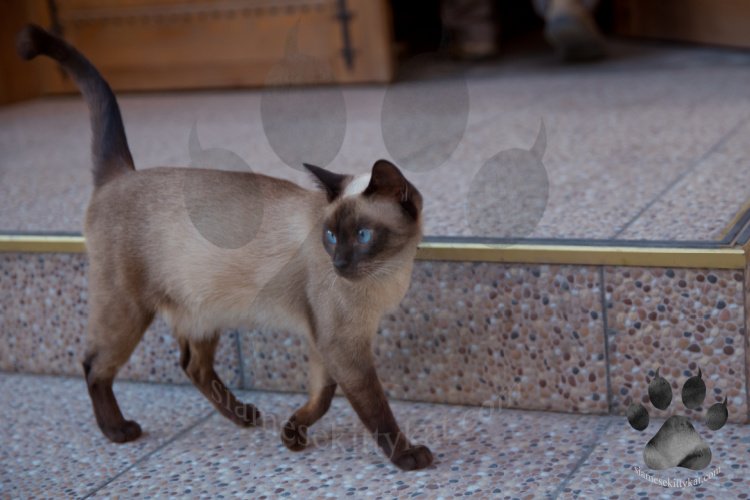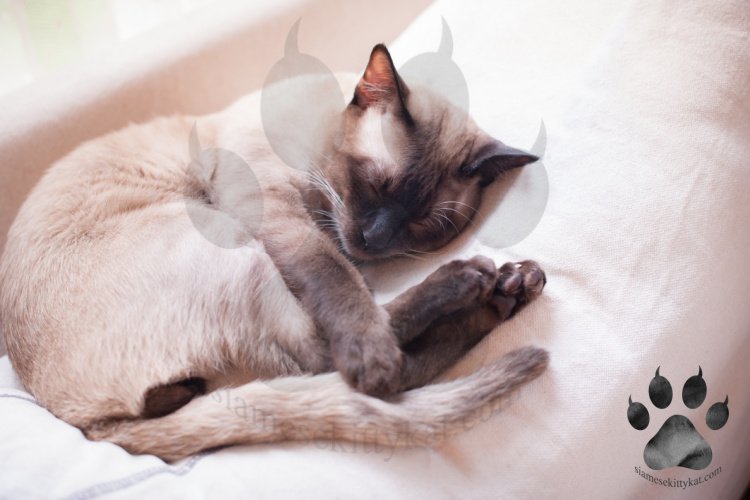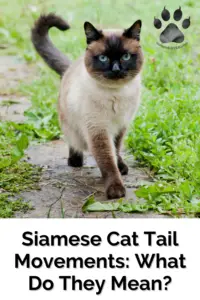Did you know that Siamese cats can communicate with you in many different ways?
While we all know that they’re absolute chatterboxes, and you’ll probably hear news from them quicker than you read it online, their tail movements are also another form of communication.
You may think you have the tail lingo down because of dogs and their tails, but cats tails’ speak in an entirely different language. For example, if their tail is swishing back and forth quickly, you should probably be running for the hills instead of saying “good kitty!”
In this article, I’ll give you a rundown of what all your Siamese cat’s tail movements mean and what they’re trying to tell you.
What Do Cats’ Tail Movements Mean?
Cats communicate with you through vocalization, scent cues that we humans can’t detect, and body language.
If your Siamese is hissing at you, it’ll give you more indication that they’re angry compared to a swish of the tail. So, cats use a mixture of elements to paint a full picture of their feelings.
While observing their tails may not be a big enough indication of their mood, it is one of the more expressive parts of their body. They communicate not just by the position of their tail but how it moves.
As a general rule, happy cats will make the distance between their tail and their owner small, whereas angry or frightened cats will puff up their tail in an attempt to put some space between them.
Here is a rundown of the individual movements and what they mean.
1. Wagging Tail Angled Down
There are two emotions your Siamese could be feeling when they are wagging their tail in a low position.
If their tail is wagging low and their body is slumped, there is a chance they are feeling scared. If their tail is swishing back and forth in a relaxed manner and their body language is more mellow, chances are they are taking in their environment and feeling content.
I am so fascinated by the different reasons why Siamese cats wag their tail that I even did an in-depth research about the science behind their tail wagging. Click on the link to read the interesting facts I found out!
2. Tail Thrashing Back and Forth
If your Siamese is holding their tail rigid and wagging it back and forth rapidly, it’s time to take a step back. This indicates that they’re angry, annoyed, or ready to attack.
They use their tail to create distance between them and the annoyance, and this movement is often paired with turned-back ears and a lowered posture.
If you want my advice, leave your kitty alone!
3. Tail Flicking While Laying
If your Siamese is chilling out and wagging their tail at the same time, chances are they’re telling you to back off.
Flicking their tail while laying down is an indication of annoyance, either by you or another animal invading their space. They do not want to be bothered.
4. A High, Wagging Tail
If your Siamese has their tail high in the sky and slowly swishing or wagging their tail, all signs point to happiness. This movement is a confident one, and they’re inviting you or other animals for some playtime or love.
5. Slowly Swaying Back and Forth
This usually indicates that they’re in predatory mode.
Slowly swishing their tail often means they’re focused on something, whether that be a toy, food, item, or another animal. Unless what they’re about to catch will hurt them, don’t interfere and let your Siamese carry out their act of nature.
They might even sway their tails and then chase it. Wondering what’s the reason behind it? Find out here: Why Do Cats Chase Their Tails? You’ll Be Suprised!
6. Tail Up and Shaking
This can be both good and bad. It is good in the sense that an upright tail in a quivering motion can indicate they’re happy to see you. If you come home and your cat greats you with a shaky tail, this means they are excited to see you. If they add in little tappy toes, they’re absolutely ecstatic you’re home.
However, it can be bad news if your Siamese is un-neutered. This means they’re about to spray urine over everything you love in an attempt to mark it with their scent. Believe me; this smell is horrifying, so get your kitty neutered as soon as you can!
7. Tail Bent and Twitching
This movement may be the hardest to read since there are so many reasons for it. This is one of those times where you’ll also have to look at the rest of their body language to figure out how they are feeling.
The main reason my cats twitch their tail is when they are playing and hunting. They’re interested and alert, and if they are crouching, this especially means they’re ready to pounce.
That being said, a high twitching tail can also indicate that your Siamese is a little frustrated. The general rule is, the quicker/more their tail is moving, the more annoyed they are.
They’re basically telling you, “Hey, back off before this gets ugly.”
8. Hitting You With Their Tail
“Hello, why aren’t you paying attention to me?” is what they’re usually trying to say. Since they struggle to pet you with their own paws, using their tail to tap you gently is their little way of petting you back.
That being said, tail hitting can also mean they are lonely, hungry, irritated, or angry. So, this is another instance where you have to gorge the rest of their body language.
9. Wrapping Their Tail Around You
While you may think that this is an attempt at murder (I can’t tell you how many times I’ve fallen over my cats as they wrap themselves around my legs), this is just a sign of affection.
They are doing this to be friendly and tell that you are their human to other people or cats. It can also be a sneaky way to beg for food and attention.
What Does a Cat’s Tail Position Mean?

The position of your cat’s tail can also say a lot about how they are feeling, even when there is no movement involved.
Here is a break-down of what individual positions mean:
1. Pointing High
If your Siamese has their tail point upright and straight, chances are they’re feeling confident and content. If you’ve ever watched a kitten walk up to its mom, you’ll notice that its tails are usually pointed high, and this means they’re ready to interact.
When your Siamese approaches you with their tail in this position, it means they are ready for cuddles or playtime. If their tail twitches slightly, this shows that they’re feeling extra happy and excited.
A tail resembling a question mark is also a good sign.
2. U-Shaped
If your Siamese’s tail is sticking up and curved slightly, they are relaxed. The more curled their tail is, for example, if the tip is bending down towards their back, the more calm and welcoming they are feeling.
This is typically how cats will greet their humans or ones they are friendly with.
3. Fluffed Up Tail Pointing Up
If they are holding their tail upright and their fur is puffed out like a feather duster, this means they are very frightened or irritated. They fluff their tail up like this in an attempt to look scarier (even though their puffy tail just makes them look cuter).
This tail position is often paired with an arched back, fur standing up on their back, and ears facing down. If you catch your Siamese in this position, leave them alone. If they’re doing this because there is a threat, as in another animal or unknown human, try to remove it.
4. 50-degree Angle
When your Siamese sticks their tail out at an angle, this can indicate that they’re unsure of their feelings.
If they’ve just encountered another animal or a new human, and they don’t know what to make of them, they may stick their tail out in indifference.
5. Relaxed Tail
A relaxed tail will often hang down until it almost touches the floor. If your Siamese is showing signs of content, such as ears pointing up and their head held high, this means they are feeling relaxed.
That being said, a lower tail can also mean your Siamese is feeling anxious or frightened.
6. Pointing Straight Out
When your cat points their tail straight behind them, this is considered a neutral position. They could be confident, relaxed, uneasy, or curious. To fully understand how they are feeling, you’ll have to take note of the rest of their body language.
7. Puffed Up Tail Pointing Down
All signs point to fear and aggression. A cat that fluffs up its tail and points it downwards is getting ready to attack, usually as a defense. They will spike up all the fur on their body in an attempt to look big and scary.
If your Siamese is showing you their puffed-up tail, it is best to walk away as you could be seen as the threat.
8. Tail Touching The Ground
If your Siamese is laying their tail on the ground, this could also mean they’re feeling defensive. Since they may follow up with aggressive behavior, it is best to either leave them alone or try to eliminate the threat.
9. Tail Curled Underneath or Next to Them
When a cat tucks its tail underneath itself, it could mean a few things.
They could be feeling scared, nervous, or showing that they’re submissive. This will often be accompanied by flattened ears and an all-around upset body language. Since your Siamese feels stressed, it would be best to pinpoint the issue and remove it from their environment.
A curled-up tail can also indicate your Siamese is in pain. If they’ve spent a few days sleeping with their tail curled towards them, especially if their head is tucked into their body, I recommend taking a trip to the vets to ensure all is well.
10. Tail Between The Legs
As cute as this may look, tucking their tail between their legs is actually an indication that they’re upset or scared.
When cats are ready to attack, they’ll try to puff themselves up as much as possible. When saying “leave me alone,” they’ll try to look as small as possible.
If your Siamese is in this position, don’t bother them. They are already warning you that they aren’t down for playing, so don’t be surprised if they scratch or bite when cornered.
Why do cats wag their tails while sleeping?

Just like us humans, cats twitch in their sleep. If your Siamese is in a deep sleep or they have a good dream, their tail may begin to twitch.
Batman, my Siamese, often wags his tail in his sleep. We call him ‘Moo’ sometimes since he reminds us of a cow trying to bat the flies away from his face; I’m surprised he doesn’t wake himself up!
Another reason may be that your Siamese isn’t sleeping at all. If you call their name and they don’t come to you, but instead, they slowly begin to wag their tails, chances are they’re deciding if they can be bothered to move or not.
The swish of the tail signals that he knows you’re there, and he hears you.
Why do cats wag their tail while hunting?
Batman and Robyn often sit at the window to watch the world go by. As they do so, their tails usually swish and swoop, sometimes so energetically that they would knock things off the windowsill.
This usually happens when they are watching birds outside and is often accompanied by a bizarre clicking sound and the hair standing up on their backs.
Well, their tail can actually help keep their agility and balance, so by wagging their tail while hunting, they’re getting ready to pounce.
Do cats wag their tails when happy?
So, we know that dogs wag their tails when they are happy, but how about cats? While it may not be the same level of wagging as an enthusiastic dog, cats do, in fact, wag their tails when happy.
You’ll know your Siamese is feeling content when they walk around with their head held high, pointing their tail straight into the clouds. Their tail may be slightly curved, resembling the shape of a question mark, or wagging softly.
Their tails also wag more energetically when playing. Batman and Robyn often play fight, and sometimes I have a hard time knowing when they’re overstepping the boundaries of playing and turning it into a full-on battle. However, a good indication is when their tail is swishing and wagging, as opposed to puffed up like a pipe cleaner.
Why do Siamese cats tails kink?
Legend has it that a long time ago, when Siamese cats were only native to Siam, these kitties were put in charge of guarding the royal goblet. They would curl their tails around the base of the goblet to ensure it always stayed with them. Due to staying in this position for long periods, their tails became kinked as a result.
Another tale involves a Siamese princess using cat’s tails to hold her rings while bathing.
Whichever legend you believe, you typically won’t see Siamese kitties with bent tails anymore since this trait was bred out a long time ago. Even if your Siamese were born with a kinked tail, they most likely wouldn’t feel any pain since it is hereditary.
Siamese who have a kinked tail developed later in life have probably been involved in an accident that resulted in a broken tail.
A friend of mine has a cat with a kink in his tail. When I asked what had happened, he said that a motorbike had run over his tail.
Thankfully, the kitty was quickly seen to and is now fine. However, because this break didn’t heal properly, his tail now has a noticeable kink, and it doesn’t cause him any pain. However, he did have some trouble remembering how to walk and play properly with his newfound tail.
What is my cat telling me?
It can be rather challenging to figure out what your cat is telling you just by looking at its tail. While some movements, like swishing rapidly back and forth, can be easy to pick up on, others can mean a whole range of things.
That’s why it is important to take note of the rest of their body language; if they’re standing tall and proud, if they’re walking close to the floor, their ears and bent down, and their hair is puffed up.
All of these are forms of communication, and since your Siamese can’t vocally tell you (even though they try!), it is your job to pick up on the signs.
Want to learn more about your Siamese cat’s behavior? We have compiled every information you need to navigate through the fascinating world of Siamese cats: Everything About a Siamese Cat’s Behavior: A Comprehensive Guide
Get your FREE Siamese Cat 2024 Printable Calendar


